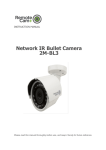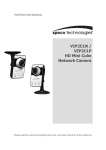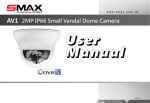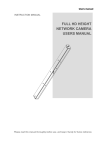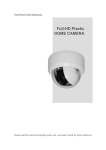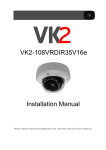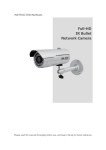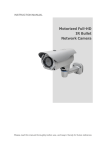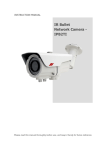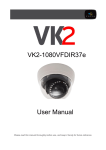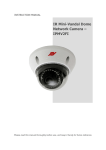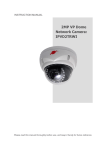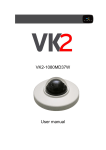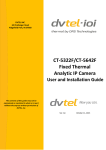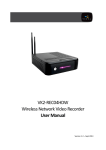Download 2M-D3W User`s Manual
Transcript
INSTRUCTION MANUAL Network Flat Dome Camera 2M-C3W Please read this manual thoroughly before use, and keep it handy for future reference. WARNING TO REDUCE THE RISK OF FIRE OR ELECTRIC SHOCK, DO NOT EXPOSE THIS PROCUCT TO RAIN OR MOISTURE. DO NOT INSERT ANY METALLIC OBJECT THROUGH THE VENTILATION GRILLS OR OTHER OPENNINGS ON THE EQUIPMENT. CAUTION EXPLANATION OF GRAPHICAL SYMBOLS The lightning flash with arrowhead symbol, within an equilateral triangle, is intended to alert the user to the presence of uninsulated "dangerous voltage" within the product’s enclosure that may be of sufficient magnitude to constitute a risk of electric shock. The exclamation point within an equilateral triangle is intended to alert the user to the presence of important operating and maintenance (servicing) instructions in the literature accompanying the appliance. PRECAUTIONS Safety -------------------------------------- Installation ------------------------------Should any liquid or solid object fall into the cabinet, unplug the unit and have it checked by the qualified personnel before operating it any further. Do not install the unit in an extremely hot or humid place or in a place subject to excessive dust, mechanical vibration. Unplug the unit from the wall outlet if it is not going to be used for several days or more. To disconnect the cord, pull it out by the plug. Never pull the cord itself. The unit is not designed to be waterproof. Exposure to rain or water may damage the unit. Allow adequate air circulation to prevent internal heat build-up. Do not place the unit on surfaces (rugs, blankets, etc.) or near materials (curtains, draperies) that may block the ventilation holes. Cleaning --------------------------------Clean the unit with a slightly damp soft cloth. Use a mild household detergent. Never use strong solvents such as thinner or benzene as they might damage the finish of the unit. Height and vertical linearity controls located at the rear panel are for special adjustments by qualified personnel only. Retain the original carton and packing materials for safe transport of this unit in the future. 2 FCC COMPLIANCE STATEMENT FCC INFORMATION: THIS EQUIPMENT HAS BEEN TESTED AND FOUND TO COMPLY WITH THE LIMITS FOR A CLASS B DIGITAL DEVICE, PURSUANT TO PART 15 OF THE FCC RULES. THESE LIMITS ARE DESIGNED TO PROVIDE REASONABLE PROTECTION AGAINST HARMFUL INTERFERENCE IN A RESIDENTIAL INSTALLATION. THIS EQUIPMENT GENERATES, USES AND CAN RADIATE RADIO FREQUENCY ENERGY AND, IF NOT INSTALLED AND USED IN ACCORDANCE WITH THE INSTRUCTIONS, MAY CAUSE HARMFUL INTERFERENCE TO RADIO COMMUNICATIONS. HOWEVER, THERE IS NO GUARANTEE THAT INTERFERENCE WILL NOT OCCUR IN A PARTICULAR INSTALLATION. IF THIS EQUIPMENT DOES CAUSE HARMFUL INTERFERENCE TO RADIO OR TELEVISOION RECEPTION, WHICH CAN BE DETERMINED BY TURNING THE EQUIPMENT OFF AND ON, THE USER IS ENCOURAGED TO TRY TO CORRECT THE INTERFERENCE BY ONE OR MORE OF THE FOLLOWING MEASURES: -- REORIENT OR RELOCATE THE RECEIVING ANTENNA. -- INCREASE THE SEPARATION BETWEEN THE EQUIPMENT AND RECEIVER. -- CONNECT THE EQUIPMENT INTO AND OUTLET ON A CIRCUIT DIFFERENT FROM THAT TO WHICH THE RECEIVER IS CONNECTED. -- CONSULT THE DEALER OR AND EXPERIENCED RADIO/TV TECHNICIAN FOR HELP CAUTION: CHANGES OR MODIFICATIONS NOT EXPRESSLY APPROVED BY THE PARTY RESPONSIBLE FOR COMPLIANCE COULD VOID THE USER'S AUTHORITY TO OPERATE THE EQUIPMENT. THIS CLASS B DIGITAL APPARATUS COMPLIES WITH CANADIAN ICES-003. CET APPAREIL NUMÉ RIQUE DE LA CLASSE B EST CONFORME À LA NORME NMB-003 DU CANADA. TO COMPLY WITH RF EXPOSURE COMPLIANCE REQUIREMENTS, THE ANTENNA USED FOR THIS TRANSMITTER MUST BE INSTALLED TO PROVIDE A SEPARATION DISTANCE OF AT LEAST 20cm (7.9in) FROM ALL PERSONS AND MUST NOT BE CO-LOCATED OR OPERATING IN CONJUNCTION WITH ANY OTHER ANTENNA OR TRANSMITTER. 3 THIS DIGITAL EQUIPMENT FULFILLS THE REQUIREMENTS FOR RF EMISSION ACCORDING TO THE CLASS B LIMIT OF EN 55022. THIS PRODUCT FULFILLS THE REQUIREMENTS FOR IMMUNITY ACCORDING TO EN 55024 OFFICE AND COMMERCIAL ENVIRONMENTS. TO COMPLY WITH RF EXPOSURE COMPLIANCE REQUIREMENTS, THE ANTENNA USED FOR THIS TRANSMITTER MUST BE INSTALLED TO PROVIDE A SEPARATION DISTANCE OF AT LEAST 20cm (7.9in) FROM ALL PERSONS AND MUST NOT BE CO-LOCATED OR OPERATING IN CONJUNCTION WITH ANY OTHER ANTENNA OR TRANSMITTER. HEREBY, REMOTECAMPLUS DECLARES THAT THIS PRODUCT IS IN COMPLIANCE WITH THE ESSENTIAL REQUIREMENTS AND OTHER RELEVANT PROVISIONS OF DIRECTIVE 1999/5/EC. A COPY OF THE ORIGINAL DECLARATION OF CONFORMITY MAY BE OBTAINED FROM REMOTECAMPLUS. [email protected] CAUTION RISK OF EXPLOSION IF BATTERY IS REPLACED BY AN INCORRECT TYPE. DISPOSE OF USED BATTERIES ACCORDING TO THE INSTRUCTIONS. 4 IMPORTANT SAFETY INSTRUCTIONS 1. 2. 3. 4. 5. 6. 7. 8. 9. 10. 11. 12. 13. 14. Read these instructions. Keep these instructions. Heed all warnings. Follow all instructions. Do not use this apparatus near water. Clean only with dry cloth. Do not block any ventilation openings. Install in accordance with the manufacturer’s instructions. Do not install near any heat sources such as radiators, heat registers, stoves, or other apparatus (including amplifiers) that produce heat. Do not defeat the safety purpose of the polarized or grounding-type plug. A polarized plug has two blades with one wider than the other. A grounding type plug has two blades and a third grounding prong. The wide blade or the third prong are provided for your safety. If the provided plug does not fit into your outlet, consult an electrician for replacement of the obsolete outlet. Protect the power cord from being walked on or pinched particularly at plugs, convenience receptacles, and the point where they exit from the apparatus. Only use attachments/accessories specified by the manufacturer. Use only with the cart, stand, tripod, bracket, or table specified by the manufacturer, or sold with the apparatus. When a cart is used, use caution when moving the cart/apparatus combination to avoid injury from tip-over. Unplug this apparatus during lightning storms or when unused for long periods of time. Refer all servicing to qualified service personnel. Servicing is required when the apparatus has been damaged in any way, such as power-supply cord or plug is damaged, liquid has been moisture, does not operate normally, or has been dropped. 15. CAUTION – THESE SERVICING INSTRUCTIONS ARE FOR USE BY QUALIFIED SERVICE PERSONNEL ONLY. TO REDUCE THE RISK OF ELECTRIC SHOCK DO NOT PERFORM ANY SERVICING OTHER THAN THAT CONTAINED IN THE OPERATING INSTRUCTIONS UNLESS YOU QRE QUALIFIED TO DO SO. 16. Use satisfy clause 2.5 of IEC60950-1/UL60950-1 or Certified/Listed Class 2 power source only. 17. ITE is to be connected only to PoE networks without routing to the outside plant. 5 Contents 1. Description ------------------------------------------------------------------7 1.1 Components - ------------------------------------------------------------------------------------------ 7 1.2 Key Features - ------------------------------------------------------------------------------------------ 8 1.3 Layout ---- ------------------------------------------------------------------------------------------ 9 2. Installation ----------------------------------------------------------------- 10 2.1 Camera Installation ---- ------------------------------------------------------------------------------- 10 2.2 Network Connection and IP Assignment ---------------------------------------------------------- 12 3. Operation -------------------------------------------------------------------- 13 3.1 3.2 3.3 3.4 3.5 Access from a browser -------------------------------------------------------------------------------- 13 Access from the internet ------------------------------------------------------------------------------ 14 Setting the admin password over a secure connection ------------------------------------------- 14 Mobile App ---- ----------------------------------------------------------------------------------------- 14 2M-C3W Setup------------------------------------------------------------------------------------------ 15 3.5.1 Basic Configuration ---------------------------------------------------------------------------- 15 1) Users ------------------------------------------------------------------------------------------ 16 2) Network -------------------------------------------------------------------------------------- 17 3) Video & Image ------------------------------------------------------------------------------ 18 4) Date & Time --------------------------------------------------------------------------------- 20 3.5.2 Live View ---------------------------------------------------------------------------------------- 21 3.5.3 Video & Image -----------------------------------------------------------------------------------22 3.5.3 Event -----------------------------------------------------------------------------------------------26 1) Event-In -------------------------------------------------------------------------------------- 28 2) Event-Out ------------------------------------------------------------------------------------ 34 3) Event Map ------------------------------------------------------------------------------------ 38 3.5.4 System ------------------------------------------------------------------------------------------ 39 1) Information ---------------------------------------------------------------------------------- 39 2) Security ----------------------------------------------------------------------------------- 40 3) Date & Time --------------------------------------------------------------------------------- 43 4) Network ---------------------------------------------------------------------------------- 44 5) Language ------------------------------------------------------------------------------------- 51 6) Maintenance --------------------------------------------------------------------------------- 52 7) Support --------------------------------------------------------------------------------------- 47 3.5.5 About ------------------------------------------------------------------------------------------ 55 3.6 Playback----------------------------------------------------------------------------------------------------56 3.7 Help ------------------------------------------------------------------------------------------------------ 58 3.8 Resetting to the factory default settings ------------------------------------------------------------- 59 4. Appendix -------------------------------------------------------------------- 60 4.1 Troubleshooting ----------------------------------------------------------------------------------------- 60 4.2 Alarm Connection ---------------------------------------------------------------------------------------- 61 4.3 Preventive Maintenance -------------------------------------------------------------------------------- 61 4.4 Product Specification ------------------------------------------------------------------------------------ 62 6 1. Description The 2M-C3W supports the network service for a sensor image with progressive scan, which can be monitored on a real-time screen regardless of distances and locations. By using its dedicated program, many users are able to have an access to the 2M-C3W at once or a single user can monitor various 2M-C3Ws at the same time. It also enables users to play, store and retrieve a monitoring image by using a PC. All the settings and real-time monitoring screens are also provided through an access to the web. The 2M-C3W is fully featured for security surveillance and remote monitoring needs. It is based on the DSP compression chip, and makes it available on the network as real-time, full frame rate Motion JPEG and H.264 (or MPEG-4) video streams. 1.1 Components The system comes with the following components: Mini Camera Accessory Kit Installation CD Installation Guide Template sheet Alarm Cable Notes: 1. Check your package to make sure that you received the complete system, including all components shown above. 2. Adapter for DC 12V is not supplied. 7 1.2 Key Features • Brilliant video quality The 2M-C3W offers the highly efficient H.264 video compression, which drastically reduces bandwidth and storage requirements without compromising image quality. Motion JPEG is also supported for increased flexibility. • Triple streams The 2M-C3W can deliver triple video streams simultaneously at full frame rate in all resolutions up to 1920 x 1080 using Motion JPEG and H.264 (or MPEG-4). This means that several video streams can be configured with different compression formats, resolutions and frame rates for different needs. • Image setting adjustment The 2M-C3W also enables users to adjust image settings such as contrast, brightness and saturation to improve images before encoding takes place. • Micro-SD Recording support The 2M-C3W also supports a micro-SD memory slot for local recording with removable storage. • Improved Security The 2M-C3W logs all user access, and lists currently connected users. Also, its full frame rate video can be provided over HTTPS. • Megapixel Resolution Max 15fps @1920x1080 • • PoE This 2M-C3W can be powered through PoE, which simplifies installation since only one cable is needed for carrying power, as well as video controls. ONVIF This is a global interface standard that makes it easier for end users, integrators, consultants, and manufacturers to take advantage of the possibilities offered by network video technology. ONVIF enables interoperability between different vendor products, increased flexibility, reduced cost, and future-proof systems. 8 1.3 Layout NO 1 2 3 Name Alarm Cable Power Cable Ethernet Cable Description Yellow : Alarm input, Black : GND, Blue : Alarm output Cable for Power source (DC 12V) Cable for Ethernet (POE) Camera Dimension See the diagrams below for the exact dimension Dimensions Unit: mm 9 2. Installation 2.1 Camera Installation Carefully remove the contents from the box, and verity that nothing was damaged in shipment. 1) Make screw holes for camera on the ceiling with Template Sheet 2) Disassemble a camera by Camera Cover 3) Fix the camera set using Anchors (2x) and Screws (2x) to the ceiling. 4) Assemble Camera Cover to Dome Camera. Turn Camera Cover clockwise to complete installation Lock clockwise 10 • • Connecting to the RJ-45 Connect a standard RJ-45 cable to the network port of the 2M-C3W. Generally a cross-over cable is used for directly connection to PC, while a direct cable is used for connection to a router. Micro SD memory slot Insert the Micro SD memory card (Class 6 or avove). Connecting the Power Connect the DC 12V power adaptor to the camera. • Connecting the Wireless using WPS button The camera supports the wireless function. Follow steps for a proper operation. 1. Make sure your ROUTER (Access Point) and Operating System support WPS (Wi-Fi Protected Setup) functions. WPS enables easy setup with compatible routers. 2. Press the WPS button on the camera for more 2 seconds. You can then see the Status LED is blinking. 3. Press and hold down the WPS button on your router (some router will have a virtual button on their management software instead). Refer to your router's documentation for details using its WPS functions When WPS configuration is done, wireless connectivity will be established and the security encryption, such as WEP or WPA-PSK, will be synchronized with the router. As for IP setting, the camera's use of DHCP or static IP is determined by your configuration on the 1M-C2W via the web- based configuration of firmware. The camera's default is DHCP. Notes: 1. WPS may not work if your router is configured with a "hidden" SSID. 2. If any WPS-enabled router is not detected, the camera will search routers for 60 seconds after pressing the WPS button, and if the camera still cannot detect the router after 1 minute, the wireless setup will be cancelled. 3. If a camera is assigned with a fixed IP outside the router's network segment, wireless setup will fail. 11 2.2 Network Connection and IP assignment The 2M-C3W supports the operation through the network. When a camera is first connected to the network it has no IP address. So, it is necessary to allocate an IP address to the device with the “Smart Manager” utility on the CD. 1. Connect the 2M-C3W / device to the network and power up. 2. Start SmartManager utility (Start>All programs>SmartManager>SmartManager), the main window will be displayed, after a short while any network devices connected to the network will be displayed in the list. 3. Select the camera on the list and click right button of the mouse. You can see the pop-up menu below. 4. Select Assign IP. You can see a Assign IP window. Enter the required IP address. Note: For more information, refer to the Smart Manger User’s Manual. 12 3. Operation 1M-C2W supports Windows and Mac operating systems. The recommended browsers are Internet Explorer, Safari, Firefox, Opera and Google Chrome with Windows. NOTE: To stream Live and Playback in Browser, set your browser to allow Adobe Flash. 3.1 RemoteCamPlus Activation 1. 2. 3. 4. Start a Browser. Go to http://www.remotecamplus.com Create User ID / Password Login 3.2 Access from a Browser 1. 2. After Login, WebViewer will display your registered Cameras and NVRs. 1M-C2W Camera’s Live View page appears in your browser. 1M-C2W provides several images and video stream formats. Your requirements and the properties of your network will determine the type you use. The Live View page provides access to H.264, MPEG-4 and Motion JPEG video streams, and to the list of available video streams. 13 3.4 Mobile APP (Android and iOS) 1. 2. Start Mobile App Type User ID / Password 14 3.5 2M-C3W Setup This section describes how to configure the 2M-C3W, and is intended for product Administrators, who have unrestricted access to all the Setup tools; and Operators, who have access to the settings for Basic, Live View, Video & Image and System Configuration. You can configure the 2M-C3W by clicking Setup in the top right-hand corner of the Live View page. Click on this page to access the online help that explains the setup tools When accessing the 2M-C3W for the first time, the “Admin Password” dialog appears. Enter your admin name and password, set by the administrator. Note: If the password is lost, the 2M-C3W must be reset to the factory default settings. See “3.8 Resetting to the Factory Default Settings”. 3.5.1 Basic Configuration You can see the device information in this information page. 15 1) Users User access control is enabled by default. An administrator can set up other users, by giving these user names and passwords. It is also possible to allow anonymous viewer login, which means that anybody may access the Live View page, as described below: The user list displays the authorized users and user groups (levels): User Group Guest Operator Administrator Authority Provides the lowest level of access, which only allows access to the Live View page. An operator can view the Live View page, create and modify events, and adjust certain other settings. Operators have no access to System Options. An administrator has unrestricted access to the Setup tools and can determine the registration of all other users. Enable anonymous viewer login: Check the box to use the webcasting features. Refer to “3.5.2 Video & Image” for more details. 16 2) Network The 2M-C3W supports both IP version 4 and IP version 6. Both versions may be enabled simultaneously, and at least one version must always be enabled. When using IPv4, the IP address for the 2M-C3W can be set automatically via DHCP, or a static IP address can be set manually. If IPv6 is enabled, the 2M-C3W receive an IP address according to the configuration in the network router. There is also the option of using the Internet Dynamic DNS Service. For more information on setting the Network, please see Setup> System>Security>Network. • Obtain IP address via DHCP - Dynamic Host Configuration Protocol (DHCP) is a protocol that lets network administrators centrally manage and automate the assignment of IP addresses on a network. DHCP is enabled by default. Although a DHCP server is mostly used to set an IP address dynamically, it is also possible to use it to set a static, known IP address for a particular MAC address. • Use the following IP address - To use a static IP address for the 2M-C3W, check the radio button and then make the following settings: IP address - Specify a unique IP address for your 2M-C3W. Subnet mask - Specify the mask for the subnet the 2M-C3W is located on. Default router - Specify the IP address of the default router (gateway) used for connecting devices attached to different networks and network segments. Notes: 1. DHCP should only be enabled if using dynamic IP address notification, or if your DHCP server can update a DNS server, which then allows you to access the 2M-C3W by name (host name). If DHCP is enabled and you cannot access the unit, you may have to reset it to the factory default settings and then perform the installation again. 2. The ARP/Ping service is automatically disabled two minutes after the unit is started, or as soon as an IP address is set. 3. Pinging the unit is still possible when this service is disabled. 17 3) Video & Image • Stream1 Setting Codec: The codec settings are separated into MPEG4 and H.264. H.264 is also known as MPEG-4 Part 10. This is the new generation compression standard for digital video. This function offers higher video resolution than Motion JPEG or MPEG-4 at the same bit rate and bandwidth, or the same quality video at a lower bit rate. - Profile: There are 4 pre-programmed stream profiles available for quick set-up. Choose the form of video encoding you wish to use from the drop-down list: * H.264 HP(High Profile): The primary profile for broadcast and disc storage applications, particularly for high-definition television applications (for example, this is the profile adopted by the Blu-ray Disc storage format and the DVB HDTV broadcast service). H.264 MP(Main Profile): Primarily for low-cost applications that requires additional error robustness, this profile is used rarely in videoconferencing and mobile applications, it does add additional error resilience tools to the Constrained Baseline Profile. The importance of this profile is fading after the Constrained Baseline Profile has been defined. H.264 BP(Baseline Profile): * * 18 * Originally intended as the mainstream consumer profile for broadcast and storage applications, the importance of this profile faded when the High profile was developed for those applications. MPEG4 SP(Simple Profile): Mostly aimed for use in situations where low bit rate and low resolution are mandated by other conditions of the applications, like network bandwidth, device size etc. - Resolution: It enables users to determine a basic screen size when having an access through the Web Browser or PC program. The screen size control comes in seven modes like 1920x1080, 1280x720, 640x480, 352x240, and 320x240. Users can reset the selected screen size anytime while monitoring the screen on a real-time basis. - Bitrate control: Limiting the maximum bit rate helps control the bandwidth used by the H.264 or MPEG-4 video stream. Leaving the Maximum bit rate as 5000kbps maintains consistently good image quality but increases bandwidth usage when there is more activity in the image. Limiting the bit rate to a defined value prevents excessive bandwidth usage, but images are lost when the limit is exceeded. Note that the maximum bit rate can be used for both variable and constant bit rates. The bit rate can be set as Variable Bit Rate (VBR) or Constant Bit Rate (CBR). VBR adjusts the bit rate according to the image complexity, using up bandwidth for increased activity in the image, and less for lower activity in the monitored area. CBR allows you to set a fixed target bitrate that consumes a predictable amount of bandwidth. As the bit rate would usually need to increase for increased image activity, but in this case cannot, the frame rate and image quality are affected negatively. To partly compensate for this, it is possible to prioritize either the frame rate or the image quality whenever the bit rate needs to be increased. Not setting a priority means the frame rate and image quality are equally affected. • - Frame rate: Upon the real-time play, users should select a frame refresh rate per second. If the rate is high, the image will become smooth. On the other hand, if the rate is low, the image will not be natural but it can reduce a network load. - GOP size: Select the GOP (Group of Picture) size. If users want to have a high quality of fast image one by one, please decrease the value. For the purpose of general monitoring, please do not change a basic value. Such act may cause a problem to the system performance. For the details of GOP setting, please contact the service center. Stream2 Setting Sometimes the image size is large due to low light or complex scenery. Adjusting the frame rate and quality helps to control the bandwidth and storage used by the Motion JPEG video stream in these situations. Limiting the frame rate and quality optimizes bandwidth and storage usage, but may give poor image quality. To prevent increased bandwidth and storage usage, the Resolution, Frame rate, and Frame Quality should be set to an optimal value. - JPEG resolution: Same as the Stream1 Setting. 19 • - JPEG frame rate: Same as the Stream1 Setting. - JPEG quality: Select the picture quality. If users want to have a high quality of fast image one by one, please decrease the value. For the purpose of general monitoring, please do not change a basic value. Such act may cause a problem to the system performance. Stream3 Setting Same as the Stream1 Setting. Click the checkbox to activate the 3rd stream. When satisfied with the settings, click Save, or click Reset to revert to previously saved settings. 4) Date & Time • • Current Server Time It displays the current date and time (24h clock). The time can be displayed in 12h clock format in the overlay (see below). New Server Time Select your time zone from the drop-down list. If you want the server clock to automatically adjust for daylight savings time, select the “Automatically adjustment for daylight saving time changes”. From the Time Mode section, select the preferred method to use for setting the time: Synchronize with computer time: sets the time from the clock on your computer. 20 • Synchronize with NTP Server: the 2M-C3W will obtain the time from an NTP server every 60 minutes. Set manually: this option allows you to manually set the time and date. Date & Time Format Specify the formats for the date and time (12h or 24h) displayed in the video streams. Select Date & Time format from the drop-down list. Date Format: Specify the date format. YYYY: Year, MM: Month, DD: Day Time Format: Specify the date format. 24Hours or 12 Hours 3.5.2 Live View Live View • Video Input Mode Video Mode: Choose Video Mode you wish to use from the drop-down list: NTSC or PAL 21 3.5.3 Video & Image Basic Refer to “3.5.1 Basic Configuration > Video & Image” for more details. Image 22 • Image Appearance This page provides access to the advanced image settings for the 2M-C3W. - Brightness: The image brightness can be adjusted in the range 1-10, where a higher value produces a brighter image. Contrast: The image contrast can be adjusted in the range 1-10. Saturation: Adjust the image's contrast by raising or lowering the value in this field. Hue: The image hue can be adjusted in the range 1-10. Sharpness: Controls the amount of sharpening applied to the image. A sharper image might increase image noise especially in low light conditions. A lower setting reduces image noise, but the image would be less sharp. Enable flip image: Check this box to flip the image. Enable mirror image: Check this box to mirror the image. Enable Noise Reduction: Check this box to reduce an image noise. AE & AWB 23 • Exposure control This page provides access to the advanced exposure control settings for the 2M-C3W. * * * * * • Mode: Supports exposure modes to control the amount of light detected by the camera sensor based on settings for light conditions. The default setting is Auto with DC-IRIS. Automatic: Automatically sets the amount of light detected by the DC-IRIS and AGC. Hold Current: Fixes the exposure at its current state. Value: Select a value in the drop-down list to tune the exposure. The default setting is 5. AGC: Select a value in the drop-down list to specify the level according to the screen luminance. The default setting is 30dB. Enable Backlight Compensation: Set this checkbox to activate the BLC operation. Flicker Mode - Provides the options for flicker. 50Hz: Select at 50 Hz environments. 60Hz: Select at 60 Hz environments. Enable Long Exposure: Set this checkbox to activate the electronic shutter of the camera. Max. Shutter: Select a shutter speed value in the drop-down list. The default setting is 1/15. White Balance Control This adjusts the relative amount of red, green and blue primary colors in the image so that the neutral colors are reproduced correctly. The camera can be set to automatically adjust for the type of light and compensate for its color. Alternatively, the type of light source can be set manually. From the drop-down list, select the white balance setting suitable for the lighting used for your camera. The available options are: - Automatic: Automatic identification and compensation for the light source color. This can be used in most situations and is the recommended setting. Fixed Incandescent: Fixed color adjustment, ideal for a room with incandescent (a glow) lighting and good for a normal color temperature around 2600K. Fixed Fluorescent: Fixed color adjustment; good for fluorescent lighting with a color temperature around 4000K to 5000K. Fixed Outdoor: Fixed color adjustment for sunny, with a color temperature around 6500K to 7500K. Day & Night 24 • Day & Night Control Select the day/night mode from among three modes. * * * • Mode: Normally works in day mode. It switches automatically to night mode in a dark place. Automatic: Normally works in day mode. It switches automatically to night mode in a dark place. Day: Always works in day mode. Night: Always works in night mode. Threshold Select the day/night mode threshold. * * High: quickly changes to day mode, but slowly changes to night mode. Low: quickly changes to night mode, but slowly changes to day mode. Privacy Masking The privacy masking function allows you to mask parts of the video image to be transmitted. You can set up to eight privacy masks and the color of privacy masks is black. 25 The privacy masks are configured by Mask windows. Each window can be selected by clicking with the mouse. It is also possible to resize or delete, or move the window, by selecting the appropriate window at the mouse menu on the video screen. To create a mask window, follow steps: 1. Click the right button of mouse to see the mouse menu. 2. Select New Privacy Mask in the mouse menu. 3. Click and drag mouse to designate a mask window area. You can also modify or delete a mask window index. Select an index and then, modify items or delete button. Select “Enable” to activate the privacy masking function. Webcasting The 2M-C3W can stream live video to a website. Copy the HTML code generated on the screen and pastes it in page code of the website you want to display live video. Note: To use webcasting service, the Enable Anonymous viewer login option must be checked. Refer to “3.5.1 Basic Configuration > Users” for more details. 26 3.5.4 Event 1) Event-In On Boot This is used to trigger the event every time the 2M-C3W is started. Select “Enable” to activate the motion event. Event In – Alarm In 27 This page allows you to configure the input supported by the camera. The Port can be given as Normally Open or Normally Close state, and their Normal state can be configured. An input will be inactive as long as its Normal state equals its Current state. The 2 options for Normal state are NO (Normally Open) and NC (Normally Close). The input is activated when the Current state changes so that it no longer equals the Normal state. • Alarm In Port 1 Setting Click the Enable alarm in port1 checkbox to enable the Alarm In port 1. * Type: The default setting is NO. NO: Normally Open As an example, if the Normal state for a pushbutton connected to an input is Open circuit, this means that as long as the button is not pushed (and the Current state remains as Open circuit), the state will be inactive. NC: Normally Close When the button is pushed, the circuit is grounded, the input's state changes to Grounded circuit and the input will no longer be in its normal state - it will have become active. An input on the camera has an Open circuit when disconnected or when there is a voltage. * - Dwell time: The default setting is 60 seconds. Dwell time means how long time the alarm input signal hold on as an input signaling source. Click the Save button to save the settings, or click the Reset button to clear all of the information you entered without saving it. Manual Trigger 28 This option makes use of the manual trigger button provided on the live view page, which are used to start or stop the event type manually. Alternatively the event can be triggered via the product's API (Application Programming Interface). Motion Motion detection is used to generate an alarm whenever movement occurs (or stops) in the video image. A total of 8 Motion and/or Mask windows can be created and configured. Motion is detected in defined Motion windows, which are placed in the video image to target specific areas. Movement in the areas outside the motion windows will be ignored. If part of a motion window needs to be masked, this can be configured in a Mask window. • Pre-Viewer Motion detection windows are configured by Motion or Mask windows. Each window can be selected by clicking with the mouse. It is also possible to resize or delete, or move the window, by selecting the appropriate window at the mouse menu on the video screen. 29 To 1. 2. 3. • create a motion or mask window, follow steps: Click the right button of mouse to see the mouse menu. Select New Motion (or Mask) Window in the mouse menu. Click and drag mouse to designate a motion area. Motion Detection Setting The behavior for each window is defined by adjusting the Threshold and Sensitivity, as described below. A motion index is a set of parameters describing Window Name, Type, Threshold, Sensitivity, and Dwell Time. Window Types is one of Motion and Mask windows. - Threshold: Sets up the threshold for the motion detection. Sensitivity: Sets up the sensitivity for the motion detection. Dwell Time: Set the hold time an event lasts for the specified hold time from the point of detection of a motion. You can also modify or delete a motion index. Select an index and then, click the Modify or Delete button. Select “Enable” to activate the motion window. Network Loss This is used to trigger the event every time the network connection is failed. Select “Enable” to activate the Network Loss event. 30 2) Event-Out SMTP (E-Mail) The 2M-C3W can be configured to send event and error email messages via SMTP (Simple Mail Transfer Protocol). • SMTP (E-Mail) Setting Select “Enable” to activate the SMTP operation. Mail Server / Port: Enter the host names (or IP addresses) and port numbers for your mail server in the fields provided, to enable the sending of notifications and image email messages from the camera to predefined addresses via SMTP. Sender: Enter the email address to be used as the sender for all messages sent by the 2M-C3W. Interval: Represents the frequency of the email notification when an event occurs. Aggregate events: Shows the maximum number of emails sent within each interval. If your mail server requires authentication, check the box for Use authentication to log in to this server and enter the necessary information. User Name/Password: Enter the User Name and Password as provided by your network administrator or ISP (Internet Service Provider). 31 To ensure that the login procedure is performed as securely as possible when using SMTP authentication, you must define the weakest authentication method allowed. Login Method: Set the Weakest method allowed to the highest/safest method supported by the mail server. The most secure method is listed in the drop-down list: Login / Plain • SMTP (E-Mail) Receiver Receiver: Enter an email address. You can also register the e-mail address of recipients up to 8. • SMTP (E-Mail) Test Receiver: Enter an email address and click the Test button to test that the mail servers are functioning and that the email address is valid. FTP & JPEG When the 2M-C3W detects an event, it can record and save images to an FTP server. Images can be sent as e-mail attachments. Check the box to enable the service. • FTP Setting Server: Enter the server's IP address or host name. Note that a DNS server must be specified in the TCP/IP network settings if using a host name. Port: Enter the port number used by the FTP server. The default is 21. Use passive mode: Under normal circumstances the 2M-C3W simply requests the target FTP server to open the data connection. Checking this box issues a PASV command to the FTP server and establishes a passive FTP connection; whereby the 2M-C3W actively initiates both the FTP control and data connections to the target server. This is normally desirable if there is a firewall between the camera and the target FTP server. 32 - • Remote directory: Specify the path to the directory where the uploaded images will be stored. If this directory does not already exist on the FTP server, there will be an error message when uploading. User name/Password: Provide your log-in information. JPEG Setting Pre-event: A pre-event buffer contains images from the time immediately preceding the event trigger. These are stored internally in the server. This buffer can be very useful when checking to see what happened to cause the event trigger. Check the box to enable the pre-trigger buffer, enter the desired total length in seconds, minutes or hours, and specify the required image frequency. Post-event: This function is the counterpart to the pre-trigger buffer described above and contains images from the time immediately after the trigger. Configure as for pre-event. Prefix file name: This name will be used for all the image files saved. If suffixes are also used, the file name will take the form <prefix>.<suffix>.<extension> Additional suffix: Add either a date/time suffix or, a sequence number - with or without a maximum value HTTP Server When the 2M-C3W detects an event, HTTP Server is used to receive uploaded image files and/or notification messages. Check the box to enable the service. • HTTP Server Setting Name: The name of the HTTP event server. Use a descriptive name. URL: The network address to the server and the script that will handle the request. For example: http://192.168.12.244/cgi-bin/upload.cgi User name/Password: Provide your log-in information. 33 • HTTP Server Test When the setup is complete, the connection can be tested by clicking the Test button. Event Out – Alarm Out • Enable alarm out Click the Enable alarm out checkbox to enable the Alarm Out port. * * Type: The default setting is NO. NO: Normally Open NC: Normally Close Click the Save button to save the settings, or click the Reset button to clear all of the information you entered without saving it. 34 ▼ Record When the 2M-C3W detects an event, it can record video stream in the Micro SD Memory (not supplied) or NAS (Network Attached Device) as a storage device. Check the box to enable the service. • Record Setting Overwrite: Click checkbox to overwrite the storage device. Stream Type: You can select Stream1, Stream2, or Stream3. * Stream1: H.264 or MPEG-4 data * Stream2: MJPEG data * Stream3: You can select VIDEO or IMAGE. Pre-event: Enter pre-event time value for storage device pre-recording. Post-event: Enter post-event time value for storage device post-recording. • Record Schedule You can set the weekly recording schedule for each day. Drag or click area by a box unit at first. Clicking the block toggles the recording between on and off. Click the “All Select” button to set a schedule for the entire week or a whole day, respectively. • Device Setting Select Device Type to be recorded in the drop-down list. SD: built-in SD card CIFS: A file format for a NAS device. NFS: A file format for a NAS device. 35 Note1: Common Internet File System (CIFS) is a remote file access protocol that forms the basis for Windows file sharing, network printing, and various other network services. CIFS requires a large number of request/response transactions and its performance degrades significantly over high-latency WAN links such as the Internet. Note2: Network File System (NFS) is a network file system protocol, allowing a user on a client computer to access files over a network in a manner similar to how local storage is accessed. NFS, like many other protocols, builds on the Open Network Computing Remote Procedure Call (ONC RPC) system. * Address: Enter IP address for NAS device. * Remote Directory: Enter directory or folder location to be recorded in the NAS device. * Capacity: Enter the capacity of storage to be used. It must be less than the total storage capacity. * IP/Password: Enter ID and Password. The 2M-C3W will ask them whenever you access NAS device. * Check: Press the Check button to check the validity of Device Setting data. • Format Click the Format button to format SD card. • Device Information Show current SD card information. ▼ Event Notification 36 When the 2M-C3W detects an event, Notification Server is used to receive notification messages as a type of XML data format. Check the box to enable the service. • Event Notification Setting Notification Server URL: The network address to the server and the script that will handle the request. ▼ Boost The Boost feature is used in conjunction with event detection. When this feature is turned ON, the Framerate and Bitrate in the boost condition can be set to a different value than the ones in the normal condition field. When an event is detected, the camera will boost the Framerate and Bitrate from the normal condition to this boosted level for the duration of the event. Check the box to enable the service. • Boost Setting You can set the condition in Normal and Boost mode. - Boot Stream: Select a video stream for each condition in the drop-down list. Framerate: Select a frame refresh rate per second for each condition in the drop-down list. Bitrate control: Select VBR or CBR in the drop-down list in Normal Condition. You can’t change it in Boost Condition. Bitrate: Select a value for each condition in the drop-down list. 37 3) Event Map The event map allows you to change the settings and establish a schedule for each event trigger from the 2M-C3W. You can register the event map up to max. 15. Click Add button to make a new event map and you can see a popup window as below. 38 • General Enter the name for a new event map. • Event In Select an event type in the drop down list. • Event Out E-mail: Select email addresses you want to send via email that an event has occurred. FTP: Select checkbox beside FTP to record and saves images to an FTP server when an event has occurred. HTTP Server: It sends notification messages to an HTTP server that listens for these. The destination server must first be configured on the Event In page. Enter a message you want to send. Event Notification: It sends XML messages to an Notification server that listens for these. The destination server must first be configured on the Event In page. Boost: when an event has occurred, the camera will boost the Framerate and Bitrate from the normal condition to this boosted level for the duration of the event. Check the box to enable the Function. Record: When the 2M-C3W detects an event, it can record video stream in the Micro SD Memory (not supplied) or NAS (Network Attached Device) as a storage device. Check the box to enable the Function. 3.5.4 System 1) Information You can enter the system information. This page is very useful when you refer device information after installation. 39 • Device Name Configuration Enter the device name. • Location Configuration Enter the location information. You can enter that by four. 2) Security Users User access control is enabled by default, when the administrator sets the root password on first access. New users are authorized with user names and passwords, or the administrator can choose to allow anonymous viewer login to the Live View page, as described below: • User Setting Check the box to enable anonymous viewer login to the 2M-C3W without the user account. When using the user account, users have to try log-in at every access. • User List Setting This section shows a registered user account. Enter a user name and password to be added, and register them by pressing the Add button. You can see the pop-up window as below. 40 HTTPS For greater security, the 2M-C3W can be configured to use HTTPS (Hypertext Transfer Protocol over SSL (Secure Socket Layer)). That is, all communication that would otherwise go via HTTP will instead go via an encrypted HTTPS connection. • HTTPS Connection Policy Choose the form of connection you wish to use from the drop-down list for the administrator, Operator and Viewer to enable HTTPS connection (set to HTTP by default). HTTP HTTPS HTTP & HTTPS • Upload Certificate To use HTTPS for communication with the 2M-C3W, An official certificate issued by a CA (Certificate Authority) must be uploaded from your PC. Provide the path to the certificate directly, or use the Browse button to locate it. Then click the Upload button. Please refer to the home page of your preferred CA for information on where to send the request. For more information, please see the online help. 41 IP Filtering Checking the Enable IP address filtering box enables the IP address filtering function. Up to 256 IP address entries may be specified (a single entry can contain multiple IP addresses). Click the Add button to add new filtered addresses. When the IP address filter is enabled, addresses added to the list are set as allowed or denied addresses. All other IP addresses not in this list will then be allowed or denied access accordingly, that is, if the addresses in the list are allowed, then all others are denied access, and vice versa. See also the online help for more information. Note that users from IP addresses that will be allowed must also be registered with the appropriate access rights (Guest, Operator or Administrator). This is done from Setup> System>Security>Users. 42 3) Date & Time • Current Server Time It displays the current date and time (24h clock). The time can be displayed in 12h clock format in the overlay (see below). • New Server Time Select your time zone from the drop-down list. If you want the server clock to automatically adjust for daylight savings time, select “Automatically adjustment for daylight saving time changes”. From the Time Mode section, select the preferred method to use for setting the time: Synchronize with computer time: sets the time from the clock on your computer. Synchronize with NTP Server: the 2M-C3W will obtain the time from an NTP server every 60 minutes. Set manually: this option allows you to manually set the time and date. Note: Note that if using a host name for the NTP server, a DNS server must be configured under TCP/IP settings. 43 4) Network Setting in regard to network can be executed. Settings for IP, DNS, Host Name, Port, and ARP/Ping can be established, along with setting for DDNS, uPnP, QoS, Zeroconfig, Bonjour and wireless. Basic • IP Address Configuration: - Obtain IP address via DHCP: Dynamic Host Configuration Protocol (DHCP) is a protocol that lets network administrators centrally manage and automate the assignment of IP addresses on a network. DHCP is enabled by default. Although a DHCP server is mostly used to set an IP address dynamically, it is also possible to use it to set a static, known IP address for a particular MAC address. Use the following IP address: To use a static IP address for the 2M-C3W, check the radio button and then make the following settings: 44 * IP address: Specify a unique IP address for your 2M-C3W. * Subnet mask: Specify the mask for the subnet the 2M-C3W is located on. * Default router: Specify the IP address of the default router (gateway) used for connecting devices attached to different networks and network segments. • IPv6 Address Configuration Check this box to enable IPv6. Other settings for IPv6 are configured in the network router. • DNS Configuration DNS (Domain Name Service) provides the translation of host names to IP addresses on your network. - Obtain DNS Server via DHCP: Automatically use the DNS server settings provided by the DHCP server. Click the View button to see the current settings. Use the following DNS server address to enter the desired DNS server by specifying the following: * Domain name: enter the domain(s) to search for the host name used by the Network Camera. Multiple domains can be separated by semicolons (;). The host name is always the first part of a Fully Qualified Domain Name, for example, my server is the host name in the Fully Qualified Domain Name myserver.mycompany.com where mycompany.com is the Domain name. * DNS servers: enter the IP addresses of the primary and secondary DNS servers. • Host Name Configuration Host Name: enter the host name to be used as device information in the client software or Speco Manager. • Services HTTP port: Enter a port to receive a service through the HTTP. Default Port Number is ‘80’. HTTPS port: Enter a port to receive a service through the HTTPS. Default Port Number is ‘443’. RTSP port: Enter a port to receive a service through the RTSP. Default Port Number is ‘554’. • ARP/Ping Setting - • Enable ARP/Ping setting of IP address - The IP address can be set using the ARP/Ping method, which associates the unit's MAC address with an IP address. Check this box to enable the service. Leave disabled to prevent unintentional resetting of the IP address. Gateway Priority - Wireless: In case of network connection through the wireless AP Wire: In case of a wired network connection. 45 DDNS • Internet DDNS (Dynamic Domain Name Service) When using the high-speed Internet with the telephone or cable network, users can operate the 2M-C3W even on the floating IP environment in which IPs are changed at every access. Users should receive an account and password by visiting a DDNS service like http://www.dyndns.com/, or http://www.cctv-network.co.kr/. - Enable DDNS: Check to get DDNS service to be available. * Username: Enter an ID to access to the DDNS server. UPnP 46 The 2M-C3W includes support for UPnP™. UPnP™ is enabled by default, and the 2M-C3W then is automatically detected by operating systems and clients that support this protocol. Note: UPnP™ must be installed on your workstation if running Windows XP. To do this, open the Control Panel from the Start Menu and select Add/Remove Programs. Select Add/Remove Windows Components and open the Networking Services section. Click Details and then select UPnP™ as the service to add. NAT Traversal A broadband router allows devices on a private network (LAN) to share a single connection to the Internet. This is done by forwarding network traffic from the private network to the “outside”, that is, the Internet. Security on the private network (LAN) is increased since most broadband routers are pre-configured to stop attempts to access the private network (LAN) from the public network/Internet. Use NAT traversal when your 2M-C3Ws are located on an intranet (LAN) and you wish to make it available from the other (WAN) side of a NAT router. With NAT traversal properly configured, all HTTP traffic to an external HTTP port in the NAT router is forwarded to the 2M-C3W. Notes: For NAT traversal to work, this must be supported by the broadband router. The broadband router has many different names: “NAT router”, “Network router“, Internet Gateway”, “Broadband sharing device” or “Home firewall” but the essential purpose of the device is the same. 47 • NAT traversal Settings Enable: when enabled, the 2M-C3W attempt to configure port mapping in a NAT router on your network, using UPnP™. Note that UPnP™ must be enabled in the 2M-C3W (see System>Network>UPnP). * automatic setting: The 2M-C3W automatically search for NAT routers on your network. * manual setting: Select this option to manually select a NAT router and enter the external port number for the router in the field provided. Notes: If you attempt to manually enter a port that is already in use, an alert message will be displayed. When the port is selected automatically it is displayed in this field. To change this enter a new port number and click Save. Zeroconfig Zeroconfig allows the 2M-C3W to create and assign IP address for 2M-C3Ws and connect to a network automatically. Zero configuration networking (zeroconf), is a set of techniques that automatically creates a usable Internet Protocol (IP) network without manual operator intervention or special configuration servers. Zero configuration networking allows devices such as computers and printers to connect to a network automatically. Without zeroconf, a network administrator must set up services, such as Dynamic Host Configuration Protocol (DHCP) and Domain Name System (DNS), or configure each computer's network settings manually, which may be difficult and time-consuming. Zeroconf is built on three core technologies: 48 • • • Assignment of numeric network addresses for networked devices (link-local address auto configuration) Automatic resolution and distribution of computer hostnames (multicast DNS) Automatic location of network services, such as printing devices through DNS service discovery. Bonjour The 2M-C3W includes support for Bonjour. When enabled, the 2M-C3W is automatically detected by operating systems and clients that support this protocol. Note: Bonjour - Also known as zero-configuration networking, Bonjour enables devices to automatically discover each other on a network, without having to enter IP addresses or configure DNS servers. Bonjour is a trademark of Apple Computer, Inc. 49 Wireless Wireless settings must be the same as the access point or ad-hoc device. When changing the settings, they should always be made first in the camera and then in the wireless access point. This ensures that the camera is always accessible when making changes. • Network Select This list is the result of a network scan. Access points with a disabled SSID Broadcast will not appear unless the camera is linked to it. The 2M-C3W is currently linked to is shown in blue. A network using unsupported security is shown in grey. The following information is provided: - - SSID: The name of a wireless network (or ad-hoc device). If the same name occurs several times this means that several access points for that network were found. The camera cannot be configured to only associate with one particular access point. Security: Shows which type of security the network uses. See below for the security types supported by the camera. Signal Level: Shows the signal strength. This 2M-C3W has three security options: • WPA-/WPA2-PSK • WPA-/WPA2-Enterprise • WEP WPA-/WPA2-Enterprise is more secure than WPA-/WPA2-PSK, which in turn is more secure than WEP. 50 5) Language It will be able to select a user language. The type of language it will be able to select is the English, the French, the German, the Spanish and the Italian. 6) Maintenance 51 • Maintenance Restart: The unit is restarted without changing any of the settings. Use this method if the unit is not behaving as expected. Reset: The unit is restarted and most current settings are reset to factory default values. The settings that are not affected are: * the boot protocol (DHCP or static) * the static IP address * the default router * the subnet mask * the system time Default: The default button should be used with caution. Pressing this will return all of the 2M-C3W's settings to the factory default values (including the IP address). • Upgrade Carry out the upgrade by importing an upgrade file and pressing the Upgrade button. During the upgrade, do not turn off the power of the 2M-C3W. And try an access again after waiting five minutes or longer. • Backup Save a setting value that users enter to the 2M-C3W, to a user PC. • Restore Import and apply a setting value saved to a user PC. Note: Backup and Restore can only be used on the same unit running the same firmware. This feature is not intended for multi-configurations or for firmware upgrades. 7) Support The support page provides valuable information on troubleshooting and contact information, should you require technical assistance. 52 • Logs The 2M-C3W support system log information. Click the System Log button to get the log data. • Reports Server Report: Click the Server Report button to get the important information about the server’s status and should always be included when requesting support. Parameter List: Click the Parameter List button to see the unit’s parameters and their current settings. • Health Check - System Check: Click the System Check button to get the important information about the camera’s system resources. You can see the pop-up window below. - Media Check: Click the Media Check button to get the information about the camera’s video and audio stream. You can see the pop-up window below. 53 - Networks Check: Click the Network Check button to get the information about the camera’s network setting and traffic. You can see the pop-up window below. 54 - Hardware Check: Click the Hardware Check button to diagnose the camera’s hardware like video. 3.5.5 About The following website will provide the support information for the 2M-C3W information and operation. http://www.remotecamplus.com/Support 55 3.6 Playback The Playback window contains a list of recordings made to the memory card. It shows each recording's start time, length, the event type used to start the recording, calendar and time slice bar indicates if the recording is existed or not. The description of playback window follows. (1) Video Screen You can see the video screen when playing the video clip in the Micro SD memory (2) Playback Buttons To view a recording data in the SD local storage, select it from the list and click the Playback buttons. Go to the first: go to the beginning of the video clip. Fast backward play: Backward play: play backward of the video clip. Step backward play: go back one frame of the video clip. Pause: pause playback of the video clip. 56 Step forward play: go forward one frame of the video clip. Forward Play: play forward the video clip. Fast forward play: play fast forward of the video clip. Step forward play: go forward one frame of the video clip. Clip copy: copy the video clip. Zoom In: zoom in the video clip Full Screen: display full screen of the video. (3) Time Chart Display an hour-based search screen for the chosen date. If there is recording data, a blue section will be displayed on a 24-hour basis. (4) Search Calendar Search results from the SD local storage in the 2M-C3W connected are displayed monthly. If there is a recorded data for a particular date, a blue square on the date will be displayed. (5) Play Time Displays time of the video playing. (6) Event Search Window Select a search option in the drop-down list and click GO button. You can also enter the time period for searching. If you click Start Date or End Date zone, displays Search Calendar. (7) Event List Window Event List displays the event(s) that were recorded in the SD local storage. Select a list and click the play button. The video clip will be played. 57 3.7 Help The Help information window will be provided as a popup window so that users can open and read it without a need for log-in. It will offer a description on setting and Help page by which users can manipulate the 2M-C3W without a reference to the manual. 58 3.8 Resetting to the factory default settings To reset the 2M-C3W to the original factory settings, go to the Setup>System> Maintenance web page (described in “3.5.4 System > Maintenance”) or use the Reset button on the 2M-C3W, as described below • Using the Reset Button Follow the instructions below to reset the 2M-C3W to the factory default settings using the Reset button. 1. Switch off the 2M-C3W by disconnecting the power adapter. 2. Press and hold the Reset button with a straightened paperclip while reconnecting the power. 3. Keep the Reset button pressed during about 2 seconds. 4. Release the Reset button. 5. The 2M-C3W resets to factory defaults and restarts after completing the factory reset. Caution: When performing a Factory Reset, you will lose any settings you have saved. 59 4. Appendix 4.1 Troubleshooting Troubleshooting if problems occur, verify the installation of the 2M-C3W with the instructions in this manual and with other operating equipment. Isolate the problem to the specific piece of equipment in the system and refer to the equipment manual for further information. Problems/Symptoms The camera cannot be accessed by some clients. The camera works locally, but not externally. Poor or intermittent network connection. The camera cannot be accessed via a host name. Not possible to log in. No image using Refresh and/or slow updating of images. Images only shown in black & white. Blurred images. Poor image quality. Rolling dark bands or flickering in image. H.264 not displayed in the client. Multicast H.264 not displayed in the client. Multicast H.264 only accessible by local clients. Color saturation is different in H.264 and Motion JPEG. Video cannot be recorded. Possible Causes or Corrective Actions If using a proxy server, try disabling the proxy setting in your browser. Check all cabling and connectors. Check if there are firewall settings that need to be adjusted. Check if there are router settings that need to be configured. If using a network switch, check that the port on that device uses the same setting for the network connection type (speed/duplex). Check that the host name and DNS server settings are correct. When HTTPS is enabled, ensure that the correct protocol (HTTP or HTTPS) is used. When attempting to log in, you may need to manually type in http or https in the browser's address bar. If images are very complex, try limiting the number of clients accessing the camera. Check the Video & Image setting. Refocus the camera. Increased lighting can often improve image quality. Check that there is sufficient lighting at the monitored location. Check all image and lighting settings. Try adjusting the Exposure Control setting under AE and AWB part. Check that the correct network interface is selected in the Video & Image/Stream. Check with your network administrator that the multicast addresses used by the camera are valid for your network. Check that the Enable multicast checkbox are enabled in the System/Network/RTP tab. Checks with your network administrator to see if there is a firewall preventing viewing. Check if your router supports multicasting, or if the router settings between the client and the server need to be configured. The TTL value may need to be increased. Modify the settings for your graphics adapter. Please see the adapter's documentation for more information. Check that the SD Card is inserted properly. Check that the SD Card is formatted properly. 60 4.2 Alarm Connection The following connection diagram gives an example of how to connect a 2M-C3W. 4.3 Preventive Maintenance Preventive maintenance allows detection and correction of minor that faults before they become serious and cause equipment failure. Every three-month, perform the following maintenance. 1. 2. 3. Inspect all connection cables for deterioration or other damage. Clean components with a clean damp cloth. Verify that all the mounting hardware is secure. 61 4.4 Product Specification Main Item C A M E R A Image sensor Active Array Lens Angle of View Min. illumination Shutter Speed Video Compression Video Streaming Video Resolutions Frame Rate Protocol N E T W O R K Security Max. Connection API Programming Interface Alarm IN / OUT Alarm Events Video Buffering Motion Detection Network Time Synchronization SD Recording Software Reset Factory Reset Auto Recovery Installation Tool Upgrade Video out (CVBS) G E N E R A L Ethernet Operating Temperature Operation Humidity Power Consumption Specification 1/2.8” Progressive scan RGB CMOS 1920(H) x 1080(V) Fixed 3.7mm Lens, F1.8 89.0°(H) x 46.0(V) 0.2 Lux 1/20,000 ~ 1/30 (Slow shutter 1/15, 1/8 and 1/4) -. Motion JPEG -. MPEG-4 Part2 -. H.264 (MPEG-4 Part 10) -. Profiles: H.264 HP, MP, and BP, MPEG-4 SP Simultaneously H.264(or MPEG-4) and MJPEG Controllable Frame Rate and Bandwidth VBR/CBR H.264 and MPEG-4 1920x1080 ~ 320x240 15fps @ 1920x1080, 30fps @ 1280x720 TCP/IP, UDP, IPv4/v6, HTTP, HTTPS, QoS, FTP, uPnP, RTP, RTSP, RTCP, DHCP, ARP, Zeroconf, Bonjour Multi-user authority, HTTPS, IP Filtering, Privacy Zone Wireless: WEP, WPA-PSK, WPA2 WPS: Software WPS setup 5 API Supported, Open Platform Compatible: ONVIF Profile S IN : 1 Ext input, Motion Detection, Manual Trigger OUT : 1 Ext output -. File upload via FTP and HTTP -. Notification via E-mail, HTTP and TCP Pre and Post Alarm Yes, max. 8 programmable zone Yes Yes, Continuous/Event Yes Yes, Button/Web browser Yes SmartManager Web browser, SmartManager Yes, with AD Key (not supplied) RJ-45 10BASE-T/100BASE-TX Built-in IEEE 802.11b/g/n wireless LAN -10°C ~ 40°C 0~80% (non-condensing) DC 12V 375mA, 4.5W / PoE 93mA, 4.5W Power over Ethernet IEEE 802.3af Class0 Dimensions (H x ø) 55mm x 115 ø Unit Weight 235g 62 System Requirement for Web Browser Operating System: Microsoft Windows OS Series CPU: Intel Core 2 Duo 2Ghz or higher, 1GB RAM or more, 10GB free disk or higher VGA: AGP, Video RAM 32MB or higher (1024x768, 24bpp or higher) General performance considerations When setting up your system, it is important to consider how various settings and situations will affect performance. Some factors affect the amount of bandwidth (the bit rate) required, others can affect the frame rate, and some affect both. If the load on the CPU reaches its maximum, this will also affect the frame rate. The following factors are among the most important to consider: -. High image resolutions and/or lower compression levels (or high bitrates) result in larger images. Frame rate and Bandwidth affected. -. Accessing both Motion JPEG and H.264 video streams simultaneously. Frame rate and bandwidth affected. -. Heavy network utilization due to poor infrastructure. Frame rate and Bandwidth affected. -. Heavy network utilization via wireless router due to poor infrastructure. Frame rate and bandwidth affected. -. Viewing on poorly performing client PCs lowers perceived performance. Frame rate affected. 63 Flat Dome Network Camera http://www.remotecamplus.com Printed in Korea 64
































































